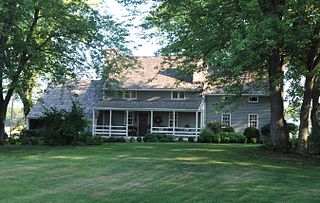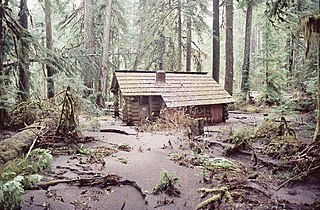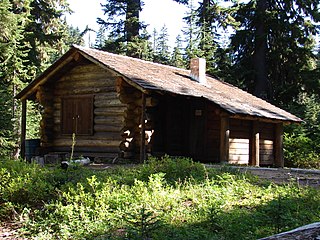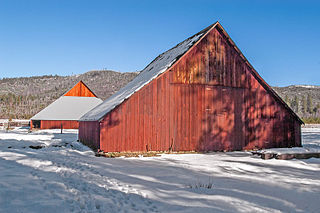
The Lake McDonald Lodge Historic District is a historic district in Glacier National Park in the U.S. state of Montana. It comprises the Lake McDonald Lodge and surrounding structures on the shores of Lake McDonald. It is centered on the main lodge, which was designated a National Historic Landmark in 1987, as well as surrounding guest cabins, dormitory buildings, employee residences, utility buildings, and retail structures. The district includes several privately owned inholding structures that are contributing structures, as well as a number of non-contributing buildings.

The Watchman Lookout Station No. 168 is one of two fire lookout towers in Crater Lake National Park in southern Oregon. For many years, National Park Service personnel used the lookout to watch for wildfires during the summer months. It is also a common hiking destination because of its views of Crater Lake and the surrounding area. The building is unusual because it serves the dual purpose of fire lookout and museum. The Watchman Lookout Station is listed on the National Register of Historic Places.

The Lake Fish Hatchery Historic District comprises nine buildings built between 1930 and 1932 by the U.S. Fish and Wildlife Service in the National Park Service Rustic style. The buildings exhibit a consistency of style and construction, with exposed gable trusses and oversized paired logs at the corners, all with brown paint. The district is located on the shore of Yellowstone lake near the Lake Hotel The hatchery was established to provide Yellowstone cutthroat trout eggs for state and federal hatcheries outside Yellowstone.

The Buckner Homestead Historic District, near Stehekin, Washington in Lake Chelan National Recreation Area incorporates a group of structures relating to the theme of early settlement in the Lake Chelan area. Representing a time period of over six decades, from 1889 to the 1950s, the district comprises 15 buildings, landscape structures and ruins, and over 50 acres (200,000 m2) of land planted in orchard and criss-crossed by hand-dug irrigation ditches. The oldest building on the farm is a cabin built in 1889. The Buckner family bought the farm in 1910 and remained there until 1970, when the property was sold to the National Park Service. The Buckner Cabin was listed on the National Register of Historic Places in 1974. The rest of the Buckner farm became a historic district in 1989. Today, the National Park Service maintains the Buckner homestead and farm as an interpretive center to give visitors a glimpse at pioneer farm life in the Stehekin Valley.

The Thomas Brown House in Inwood, West Virginia, was built about 1741 as a log cabin for Thomas Brown, a Quaker farmer. Brown was one of the first to grow fruit in an area where orchardry would become a major agricultural industry. The house is the oldest known dwelling in Berkeley County.

The Andrew Berg Cabin near Soldotna, Alaska was built by fisherman and trapper Andrew Berg in 1902. It was listed on the National Register of Historic Places in 2000.

The Wonderland Trail is an approximately 93 mile (150 km) hiking trail that circumnavigates Mount Rainier in Mount Rainier National Park, Washington, United States. The trail goes over many ridges of Mount Rainier for a cumulative 22,000 feet (6,700 m) of elevation gain. The trail was built in 1915.

The Ipsut Creek Patrol Cabin was built by the United States National Park Service in 1933 in Mount Rainier National Park to house backcountry rangers. The log cabin resembles other cabins at Huckleberry Creek, Lake James and Three Lakes, all built to standard plans from the Park Service Branch of Plans and Designs, supervised by Acting Chief Architect W.G. Carnes. The cabin is approximately 24 feet (7.3 m) by 14 feet (4.3 m), with a lean-to storage shed to the rear.

The Three Lakes Patrol Cabin was built in 1934 in Mount Rainier National Park as a district ranger station. The log cabin was built to a standard plan designed by W.G. Carnes, Acting Chief Architect of the National Park Service Branch of Plans and Designs, supervised by Thomas Chalmers Vint. The cabin measures about 13.5 feet (4.1 m) by 24 feet (7.3 m). It is a simple gable structure with a shed roof over the front door, supported by brackets. The eaves have a similar bracket detail. Log ends project prominently at the corners. It consists of a single room, unfinished apart from a wood floor.

The McCauley and Meyer Barns in Yosemite National Park are the last barns in the park that retain their original characteristics as structures built by homesteaders. The McCauley barn and the two Meyer barns represent different construction techniques and styles of design.

The Timberline Cabin in Rocky Mountain National Park, Colorado, USA was built in 1925 to house workers on the Fall River Road. The National Park Service rustic style cabin was designed by the National Park Service's Landscape Engineering Division under the direction of Thomas Chalmers Vint. The cabin was later used as a patrol cabin and as a caretaker's residence.

The Horseshoe Lake Ranger Station in Lassen Volcanic National Park, California is a backcountry ranger station that was built by Civilian Conservation Corps labor in 1934. The cabin typifies National Park Service standard designs for such structures in the prevailing National Park Service Rustic style then used by the Park Service. It is the only such example of a standard-plan backcountry ranger station in Lassen Volcanic National Park. There were originally two structures at the site, the residence, and a now-vanished barn.

The Summit Lake Ranger Station, also known as the Summit Lake Patrol Cabin, is one of the first three buildings constructed by the National Park Service in Lassen Volcanic National Park, California. Located near the center of the park on the main park road, the cabin was built in 1926. It is a log building measuring about 20 feet (6.1 m) by 30 feet (9.1 m) with an asymmetric gable roof that results in a long pitch to a low rear wall. The main portion of the station comprises a living area, kitchen, and two bedrooms. A former porch has been enclosed and houses a bathroom.

The Saint Mary Ranger Station is a ranger station in Glacier National Park in the U.S. state of Montana. The log cabin was built in 1913 on the east side of the park overlooking Upper Saint Mary Lake. The oldest administrative structures in the park., it features an architecture that foreshadows the National Park Service Rustic style.

The Ambajejus Boom House is an historic logging facility in remote central Maine. Built in 1907 on a small island in Ambajejus Lake, it is the only surviving structure associated with the great logging drives that drove the economy of inland Maine for decades. It was listed on the National Register of Historic Places in 1973. The building has been rehabilitated and can be visited by boat from various launch points on the lake.

The Dr. Elmer Bly House, also known as Bly House and The Point, is a historic log house in Port Alsworth, Alaska. It is located on a spit of land adjacent to Hardenburg Bay, an inlet of Lake Clark, and presently houses administrative offices of the Lake Clark National Park and Preserve. The house is a 1-1/2 story log structure, measuring 23 by 37 feet. It has a projecting screened arctic entrance vestibule measuring 10 by 13 feet. The logs used in its construction are sawn on three sides at a local sawmill. The house was built in 1947 by Dr. Elmer Bly, a dentist, and Joe Thompson. Bly operated his dental practice here from 1947 to 1953. It was purchased by the National Park Service 1979, at which time the interior was modernized and the exterior rehabilitated.

The Brooks Lake Lodge, also known as the Brooks Lake Hotel and Diamond G Ranch, as well as the Two-Gwo-Tee Inn, is a recreational retreat in Fremont County, Wyoming near Dubois in the upper Wind River valley. The complex was built in 1922 to accommodate travelers coming to Yellowstone National Park on U.S. Route 287 from central Wyoming. The buildings are mainly of log construction with Craftsman style detailing.

The Whaleback Snow-Survey Cabin, about 10 miles (16 km) north of Prospect in the Rogue River–Siskiyou National Forest in southwest Oregon, is a log cabin with a "snow tower" built in 1937. It is situated on the east slope of Whaleback Mountain. It was listed on the National Register of Historic Places in 2000.

The Matt Ruatsale Homestead in Valley County, Idaho, in the vicinity of Lake Fork, Idaho, was built in c.1915. The house was moved to its present location from the Ruatsale homestead site sometime prior to it being listed on the National Register of Historic Places in 1982.

The Craig Cabin was built as a trapper's cabin near Bondurant, Wyoming between 1898 and 1900. Located in the Gros Ventre Range, the log cabin was occupied by Jack Craig from about 1902, who prospected for gold in the area. Despite claims that Craig found gold, there was no evidence that he found any significant amount. Craig advertised his operation on the radio and sold shares in the mine, but was alleged to have planted what gold he had on the site. Geological surveys indicated that what gold could be found had come from higher country via stream drainage. Craig stayed at the cabin during the summer and returned home to Salt Lake City in the winter. Disputes over water made Craig unpopular among local ranchers. From 1940 the cabin was used by Arthur Bowlsby as a lodge for visiting hunters. From 1971 the cabin was used by a succession of outfitting businesses and continues in that use.




















